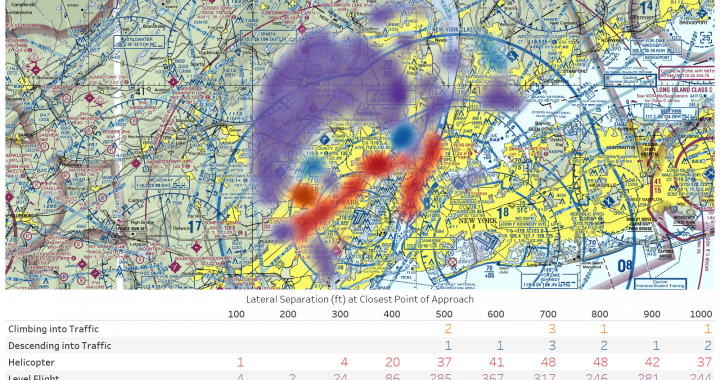Midair collisions are a persistent and deadly threat to aviation safety. From 2016 to 2021, there were 43 reports of midair collisions involving GA operations in the United States, resulting in 79 fatalities. Data from the FAA’s Aviation Safety Information and Analysis Sharing (ASIAS) GA team indicate that over time, general aviation operators with Traffic Alert and Collision Avoidance Systems (TCAS) have had a consistently higher Resolution Advisory (RA) rate — an indicator of midair collision risk — as compared to commercial (part 121) operators. This difference prompted ASIAS to perform a study on TCAS RA events, particularly within the GA community. The General Aviation Joint Steering Committee (GAJSC) later issued a report on the findings.
Over a three year period (2015-2018), ASIAS initially studied RA events at three airport locations, relying on data from algorithm-derived RAs, ADS-B equipment, Flight Operations Quality Assurance data, and text-based safety reports. At each location, areas of dense reports, or clusters, were identified and labeled based on the type of event occurring within it. These included Level Flight, Climbing Into Traffic, Descending Into Traffic, Parallel Approach, and Helicopter.
Once the initial results were validated, the study expanded to cover 50 airports in the United States with the most simulated general aviation TCAS RA events. The results for each location were intuitively displayed over a sectional to help depict the particular locations or routes where collision risk may be more likely. Clusters with darker or denser colors indicate areas with the most events. A graph also accompanies each display to illustrate the proximity of aircraft involved in the events. It is worth noting that the reasons for TCAS RA interaction vary with location, not just by airport, but by location at the airport.
While the report does not provide any specific mitigation strategies for avoiding midair collisions, it is the GAJSC’s intention that this information can provide the aviation community with useful insight on potential risk areas at certain locations in the NAS. The results have already been used by some air traffic facilities to validate changes to VFR routes that were under development.
See the report here: Midair Collision Report: February 2022

